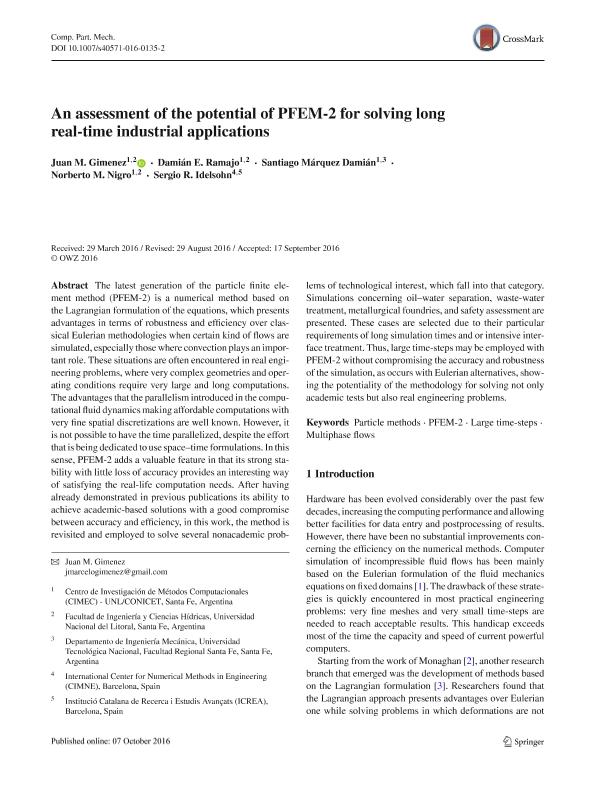Mostrar el registro sencillo del ítem
dc.contributor.author
Gimenez, Juan Marcelo

dc.contributor.author
Ramajo, Damian Enrique

dc.contributor.author
Marquez Damian, Santiago

dc.contributor.author
Nigro, Norberto Marcelo

dc.contributor.author
Idelsohn, Sergio Rodolfo

dc.date.available
2018-03-07T22:05:03Z
dc.date.issued
2017-07
dc.identifier.citation
Gimenez, Juan Marcelo; Ramajo, Damian Enrique; Marquez Damian, Santiago; Nigro, Norberto Marcelo; Idelsohn, Sergio Rodolfo; An assessment of the potential of PFEM-2 for solving long real-time industrial applications; Springer International Publishing; Computational Particle Mechanics; 4; 3; 7-2017; 251-267
dc.identifier.issn
2196-4378
dc.identifier.uri
http://hdl.handle.net/11336/38254
dc.description.abstract
The latest generation of the particle finite element method (PFEM-2) is a numerical method based on the Lagrangian formulation of the equations, which presents advantages in terms of robustness and efficiency over classical Eulerian methodologies when certain kind of flows are simulated, especially those where convection plays an important role. These situations are often encountered in real engineering problems, where very complex geometries and operating conditions require very large and long computations. The advantages that the parallelism introduced in the computational fluid dynamics making affordable computations with very fine spatial discretizations are well known. However, it is not possible to have the time parallelized, despite the effort that is being dedicated to use space–time formulations. In this sense, PFEM-2 adds a valuable feature in that its strong stability with little loss of accuracy provides an interesting way of satisfying the real-life computation needs. After having already demonstrated in previous publications its ability to achieve academic-based solutions with a good compromise between accuracy and efficiency, in this work, the method is revisited and employed to solve several nonacademic problems of technological interest, which fall into that category. Simulations concerning oil–water separation, waste-water treatment, metallurgical foundries, and safety assessment are presented. These cases are selected due to their particular requirements of long simulation times and or intensive interface treatment. Thus, large time-steps may be employed with PFEM-2 without compromising the accuracy and robustness of the simulation, as occurs with Eulerian alternatives, showing the potentiality of the methodology for solving not only academic tests but also real engineering problems.
dc.format
application/pdf
dc.language.iso
eng
dc.publisher
Springer International Publishing

dc.rights
info:eu-repo/semantics/openAccess
dc.rights.uri
https://creativecommons.org/licenses/by-nc-sa/2.5/ar/
dc.subject
Large Time-Steps
dc.subject
Multiphase Flows
dc.subject
Particle Methods
dc.subject
Pfem-2
dc.subject.classification
Ingeniería Mecánica

dc.subject.classification
Ingeniería Mecánica

dc.subject.classification
INGENIERÍAS Y TECNOLOGÍAS

dc.title
An assessment of the potential of PFEM-2 for solving long real-time industrial applications
dc.type
info:eu-repo/semantics/article
dc.type
info:ar-repo/semantics/artículo
dc.type
info:eu-repo/semantics/publishedVersion
dc.date.updated
2018-03-07T15:54:45Z
dc.identifier.eissn
2196-4386
dc.journal.volume
4
dc.journal.number
3
dc.journal.pagination
251-267
dc.journal.pais
Alemania

dc.journal.ciudad
Berlín
dc.description.fil
Fil: Gimenez, Juan Marcelo. Consejo Nacional de Investigaciones Científicas y Técnicas. Centro Científico Tecnológico Conicet - Santa Fe. Centro de Investigaciones en Métodos Computacionales. Universidad Nacional del Litoral. Centro de Investigaciones en Métodos Computacionales; Argentina. Universidad Nacional del Litoral. Facultad de Ingeniería y Ciencias Hídricas; Argentina
dc.description.fil
Fil: Ramajo, Damian Enrique. Universidad Nacional del Litoral. Facultad de Ingeniería y Ciencias Hídricas; Argentina. Consejo Nacional de Investigaciones Científicas y Técnicas. Centro Científico Tecnológico Conicet - Santa Fe. Centro de Investigaciones en Métodos Computacionales. Universidad Nacional del Litoral. Centro de Investigaciones en Métodos Computacionales; Argentina
dc.description.fil
Fil: Marquez Damian, Santiago. Consejo Nacional de Investigaciones Científicas y Técnicas. Centro Científico Tecnológico Conicet - Santa Fe. Centro de Investigaciones en Métodos Computacionales. Universidad Nacional del Litoral. Centro de Investigaciones en Métodos Computacionales; Argentina. Universidad Tecnológica Nacional; Argentina
dc.description.fil
Fil: Nigro, Norberto Marcelo. Universidad Nacional del Litoral. Facultad de Ingeniería y Ciencias Hídricas; Argentina. Consejo Nacional de Investigaciones Científicas y Técnicas. Centro Científico Tecnológico Conicet - Santa Fe. Centro de Investigaciones en Métodos Computacionales. Universidad Nacional del Litoral. Centro de Investigaciones en Métodos Computacionales; Argentina
dc.description.fil
Fil: Idelsohn, Sergio Rodolfo. International Center for Numerical Methods in Engineering; España. Institució Catalana de Recerca i Estudis Avancats; España. Consejo Nacional de Investigaciones Científicas y Técnicas. Centro Científico Tecnológico Conicet - Santa Fe. Instituto de Desarrollo Tecnológico para la Industria Química. Universidad Nacional del Litoral. Instituto de Desarrollo Tecnológico para la Industria Química; Argentina
dc.journal.title
Computational Particle Mechanics
dc.relation.alternativeid
info:eu-repo/semantics/altIdentifier/url/http://link.springer.com/article/10.1007/s40571-016-0135-2
dc.relation.alternativeid
info:eu-repo/semantics/altIdentifier/doi/http://dx.doi.org/10.1007/s40571-016-0135-2
Archivos asociados
